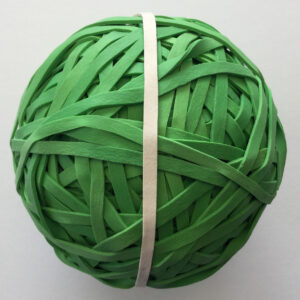Well-managed brands are built by telling a series of stories that consistenly communicate – even prove – the brand’s valuable point of difference.
In some cases, the company takes control of the way the story is told by advertising or sponsoring a program that reinforces the brand. In other cases, the company earns the brand-building story when one of their customers posts a review or shares some content through social media. And sometimes, unfortunately, the company loses control of the story when the brand appears in the news in a negative light.
At the end of the day, a brand is the sum total of all the stories told about it. Well-managed brands result from a collection of stories that consistently communicate the same valuable point of difference.

Let’s compare a brand to one of those balls that are made up of rubber bands. A well-managed brand is a ball made up of many rubber bands of the same color.
Why would a company dedicate so much time and effort to making sure that all of the stories told about their brand are consistently make the same point? Well I can think of two reasons right away.
The first one is that a well-managed brand short-circuits their customers’ decision-making process. In other words, when that brand really owns a position in your mind, you don’t really shop around for alternatives. For instance, I’m a Jiffy Lube guy. So the last time I needed to change the oil in my car, I drove three or four miles to the nearest Jiffy Lube. Of course, on my way there, I probably drove by half a dozen places that might have done the job faster and cheaper than Jiffy Lube. I didn’t consider them, because I didn’t see them. Because I’m a Jiffy Lube guy.
Secondly, by short-circuiting the customers’ decision-making process, the likelihood that they can charge a premium price for the branded product increases.
Sometimes they earn a premium by charging more money for each item. For instance, when you buy a BMW or when you buy an iPad, you knowingly give those companies a premium price. And sometimes they earn a premium by garnering a large share of the customers’ purchases in a given category. For instance, Amazon doesn’t get a premium on every book you purchase from them, but if you buy all your books from Amazon, they essentially have 100% of your book business.
Now, if you are wondering what this has to do with you, well, you sell communication tools. You sell rubber bands. You have assets that can help your clients communicate with their target consumers. But of course your assets are like white rubber bands. They actually look like your brand and not the client’s. And the mistake that a lot of companies make is that they take their tools right off of the shelf, slap them on a proposal, and submit it to a client.

Just like a white rubber band on a green rubber band ball, everyone can see from a mile away that the tool being presented has nothing to do with the client’s brand. In the words of a Brand Manager I heard speak at a conference, “when you send me an idea that isn’t connected to my brand and doesn’t help me accomplish a marketing objective, your proposal goes to the bottom of the pile.”
So what do we propose? We propose that you take those wonderful assets that you have successfully built into great story-telling tools and customize them so that they look like the client, they support the client’s brand, and they prove the valuable point of difference to your audience.
When you do that consistently, you will begin to build a brand as a source of marketing ideas which will allow you to short-circuit your customers’ decision-making process and increase the likelihood that you can charge a premium for your tools.




